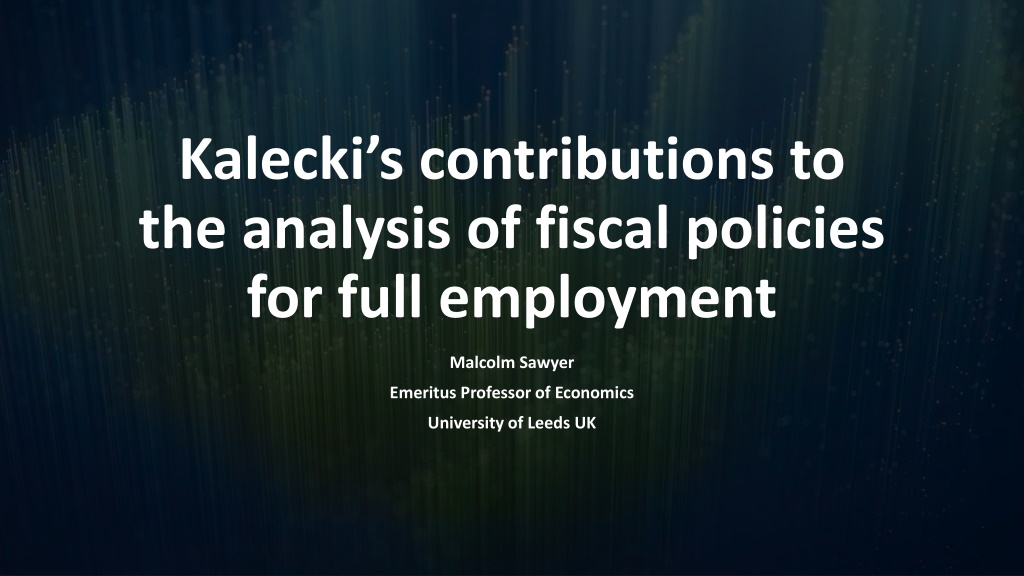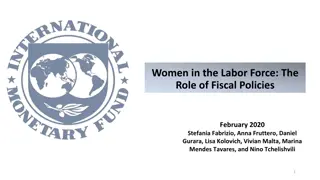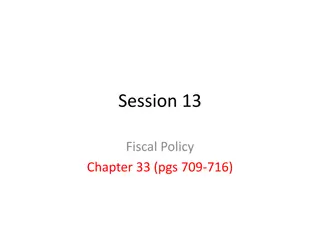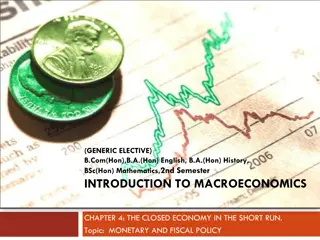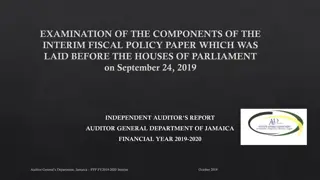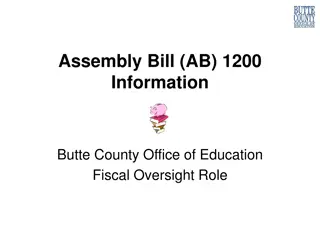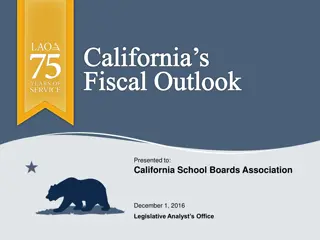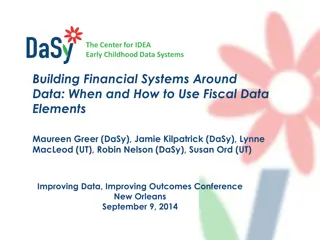Kalecki's Analysis of Fiscal Policies for Full Employment
Malcolm Sawyer discusses Kalecki's contributions to analyzing fiscal policies for achieving full employment. The content covers topics such as financing public and private expenditure, the role of budget deficits in maintaining full employment, the impact of public debt, and obstacles to achieving full employment. Kalecki's insights on the financing and funding of public and private spending are highlighted, emphasizing the importance of government intervention in stimulating economic activity and employment.
Download Presentation

Please find below an Image/Link to download the presentation.
The content on the website is provided AS IS for your information and personal use only. It may not be sold, licensed, or shared on other websites without obtaining consent from the author. Download presentation by click this link. If you encounter any issues during the download, it is possible that the publisher has removed the file from their server.
E N D
Presentation Transcript
Kaleckis contributions to the analysis of fiscal policies for full employment Malcolm Sawyer Emeritus Professor of Economics University of Leeds UK
Introduction Purpose is to highlight aspects of Kalecki s writings on fiscal policy and unemployment which have bearing on recent debates on austerity and fiscal consolidation. Cover four main areas: Financing and funding of public and of private expenditure The need for budget deficits to underpin full employment and the impossibilities of balanced structural budgets The (non) burden of public debt and the fiscal burden of interest payments Remarks on political and social obstacles to full employment
Financing and funding of public expenditure The circuitist distinction between initial financing and final financing using Mehrling s terminology payment and funding. In papers written in the first half of the 1930s, Kalecki indicated that government expenditure (often infrastructure investment) would be (initial) financed by central bank credits. Kalecki noted that a fiscal expansion could come from the government obtaining large credits from the central bank and spending them on massive public works of one sort or another. In this case the money no doubt would be spent and this would result in increased employment (Kalecki, 1932b, p.175). He often proceeded to note the effects of the additional public expenditure on profits.
Financing and funding public expenditure Kalecki illustrated the financing of public spending by means of a thought experiment. imagine for a moment that the government pays its suppliers in government securities. The suppliers will, in general, not retain these securities but put them into circulation while buying other goods and services, and so on, until these securities will reach people or firms which retain them as interest- yielding assets. In any period of time the total increase in government securities in the possession of persons and firms will be equal to the goods and services sold to the government. Thus, what the economy lends to the government are goods and services whose production is financed by government securities. In reality, the government pays for the services, not in securities, but in cash, but it simultaneously issues securities and so drains the cash off, and this is equivalent to the imaginary process described above. (Kalecki, 1944a, pp. 347- 348)
Financing and funding private expenditure the financing of additional investment is effected by the so- called creation of purchasing power. The demand for bank credit increases, and these are granted by the banks (Kalecki, 1935, p.190). Kalecki presented ideas which can be seen as now embedded in the structuralist post Keynesian analysis of endogenous money and in the circuitist approach. Messori (1991) argued that Kalecki did not differentiate enough between the two different meaning of financing: the monetary flows required to finance an increase in the demand for capital goods (investment financing), and the monetary advances required to finance the purchase of working capital (production financing).
Full employment and balanced budgets For the UK: in normal times, governments of the left as well as the right should run a budget surplus to bear down on debt and prepare for an uncertain future , and that in the Budget we will bring forward this strong new fiscal framework to entrench this permanent commitment to that surplus, and the budget responsibility it represents. (Osborne, 2015). Within the European Union, the fiscal compact was adopted by 26 of the 28 member countries. Amongst the measures agreed was a balanced structural budget. A structural budget position is calculated as that which would appertain if the economy were operating at potential output and government expenditure and tax rates maintained at their current levels.
Full employment and balanced budgets Potential output is the level of output at which inflation would be expected to be constant. It may correspond with the non-accelerating inflation rate of unemployment (NAIRU). There are a range of what may be termed technical objections to the construction and use of a structural budget. These include the issues of the estimation of potential output and the degree to which estimates of potential output have path dependent effects on output. The focus on potential output is in effect an abandonment of any notion of full employment. Kalecki would have viewed the achievement of full employment as requiring not only the appropriate level of aggregate demand supported by fiscal policy but also the creation of sufficient productive capacity.
Full employment and balanced budgets Kalecki (1944b) argued for a permanent budget deficits in the face of intentions to save exceeding intentions to invest. He criticised those who accepted that budget deficits would rise during economic downswings but who did not accept the arguments for the need for permanent budget deficits. Kalecki argued that there will emerge out of a consistent anti- cyclical policy a certain more or less stable level of private investment which by itself, i.e. without considerable assistance by loan expenditure of the public authorities, may fall short of the level required to fill the gap of savings out of a full employment income.
Full employment and balanced budgets The question can be simply posed in the following terms. Consider the equilibrium requirement G T = S- I (closed economy for simplicity) The requirement for a balanced structural budget is the requirement that savings and investment intentions would be balanced at potential output. Kalecki s answer would surely have been that those intentions would not be balanced. Keynes is frequently quoted as saying that Look after the unemployment, and the budget will look after itself. (Keynes, 1933). From a Kaleckian perspective, a revival of private demand, whether coming in some sense autonomously or through some policy stimulus), would lower unemployment and lower the budget deficit.
Burden of debt The claim that budget deficits burden future generations has often been made: for example, public borrowing is, in essence, taxation deferred, and it would be irresponsible and unfair to accumulate substantial debts to fund spending that benefits today s generation at the expense of subsequent generations (HM Treasury, 2010, p.11). Kalecki clearly stated that interest on an increasing national debt (as indeed on all debt) cannot be a burden to society as a whole because in essence it constitutes as internal transfer.
Burden of debt Consider the case where the government runs a budget deficit which averages (relative to GDP) d. A continuing primary budget deficit (relative to GDP) of d leads to a debt (relative to GDP) of b = d/(g -r ) where g is the growth rate and r the rate of interest on government debt, which requires g > r for sustainability. It is well-known that such a deficit will lead the debt ratio to converge to b = d/g with the deficit (in the long term) becoming d* + r.b where r is the rate of interest on government debt and d* the primary deficit. The d = d* + r.d/g and d* = [(g r)/r]. d which is positive if g > r (i.e. a deficit) and negative (i.e. a surplus) if g < r. The total budget deficit then eventually reaches b + r.d. When it is total budget deficit ratio which is held constant, then debt ratio converges on d/g (where g is the nominal growth rate) though the composition of the budget deficit moves towards interest payments, and the primary budget position converges on (g r).b and interest payments on r.b.
Burden of debt Consider the situation (as at present with the pandemic; during war when Kalecki was writing) where the budget deficit has sharply risen and the debt ratio has jumped. Kalecki (1943) discussed the burden of the national debt , in terms of a financial burden in that interest has to be paid out. With a particular level of budget deficit required to secure full employment, then a higher amount of interest payments would tend to reduce the level of government expenditure consistent with that level of budget deficit. Kalecki advocated an annual capital tax, levied on firms and individuals which would raise money to finance the interest payments on the national debt which would affect neither capitalists consumption nor the profitability of investment (Kalecki, 1944a, p. 363).
Burden of debt Some invoked the argument for a negative relationship between the size of public debt and the rate of growth (at least above some threshold level of debt); sometimes combined by a falling off a cliff argument above some crucial level, economic decline would set in. [o]ur main result is that whereas the link between growth and debt seems relatively weak at normal debt levels, median growth rates for countries with public debt over roughly 90 percent of GDP are about one percent lower than otherwise; average (mean) growth rates are several percent lower. Surprisingly, the relationship between public debt and growth is remarkably similar across emerging markets and advanced economies (Reinhart and Rogoff, 2010, p. 573).
Burden of debt The results of Reinhart and Rogoff were debunked by Herndon et alia (2014). A more recent study found that with further hindsight, and from a time series perspective, there is little to no support for the view that higher levels of debt cause reductions in economic activity. In contrast to Reinhart and Rogoff (2010), we suggest that economic slumps tend to cause debt build-ups rather than vice versa (Amann and Middleditch, 2020). In Sawyer (2017), I considered further empirical evidence and argued that the evidence for a negative relationship between debt ratio and economic growth could be severely questioned.
Social and political obstacles to full employment Kalecki wrote that a solid of majority of economists is now [that is 1943] of the opinion that, even in a capitalist economy, full employment may be secured by a government spending programme, provided there is in existence adequate plan to employ all existing labour power, and provided adequate supplies of necessary foreign raw-materials may be obtained in exchange for exports (Kalecki, 1943 p.347). Kalecki (1944) evaluated three ways to full employment of which budget deficit was one, with re-distribution of income another one which Kalecki favoured, though back of the envelope calculations suggest that while re-distribution could play a role it may be a relatively minor one (depending on the differences in the propensities to spend of the different income groups).
Social and political obstacles to full employment Kalecki warned that those opposed to the idea that full employment can be achieved by government spending there were (and are) prominent so-called economic experts closely connected with banking and industry. This suggests that there is a political background in the opposition to the full employment doctrine, even though the arguments advanced are economic. That is not to say that people who advance them do not believe in their economics, poor though it is. But obstinate ignorance is usually a manifestation of underlying political motives. (1943, p. 349).
Social and political obstacles to full employment Osborne (2010) argued that concluded that a credible fiscal consolidation plan will have a positive impact through greater certainty and confidence about the future. Kalecki had noted that under a laissez-faire system the level of employment depends to a great extent on the so-called state of confidence. If this deteriorates, private investment declines, which results in a fall of output and employment . This gives the capitalists a powerful indirect control over government policy: everything which may shake the state of confidence must be carefully avoided because it would cause an economic crisis, Hence budget deficits necessary to carry out government intervention must be regarded as perilous. The social function of the doctrine of sound finance is to make the level of employment dependent on the state of confidence. (Kalecki, 1943, p. 350)
Social and political obstacles to full employment Kalecki (1943, pp. 347-56) raised a number of social and political obstacles to the achievement of prolonged full employment in a laissez faire capitalist economy. He argued that under sustained full employment the social position of the boss would be undermined, and the self-assurance and class consciousness of the working class would grow. Strikes for wage increases and improvements in conditions of work would create political tensions (Kalecki, 1943, p.351).
Social and political obstacles to full employment Kalecki saw laissez-faire capitalism as inconsistent with sustained full employment. Full employment capitalism will, of course, have to develop new social and political institutions which will reflect the increased power of the working class. If capitalism can adjust itself to full employment, a fundamental reform will have been incorporated in it. If not, it will show itself an outmoded system which much be scrapped. (Kalecki, 1943, p. 356). Kalecki and Kowalik (1971) argued that a crucial reform imposed on the ruling class may stabilize the system, temporarily at least. we have to do with just such a situation in contemporary capitalism (p. 467). Government intervention in the expansion of markets became an institution, making it possible to limit unemployment to a few per cent This state of affairs (along with a considerable expansion of social security) led to a certain transformation of the working class, which on the whole became radically reformist in its attitude towards capitalism. Preserving high employment rates in the leading capitalist countries generally gives the workers a satisfactory level of real income. (pp. 472-3)
Social and political obstacles to full employment King (2013): by 1971 the crucial reform was already beginning to unravel (p.32). Five aspects: collapse of Bretton Woods system of fixed exchange rates, leading to increased financial instability; financialisation; unwinding of first five principles of social democracy ; tendency for the various varieties of capitalism to approach the Anglo-Saxon model; and the so-called Great Moderation after 1992. The unravelling of the crucial reform and the ushering in of the eras of neo-liberalism, globalisation and financialisation have been accompanied by rising inequality and generally slower economic growth. In recent years (say last two decades), unemployment in industrialised countries has fluctuated and has rarely come close to what may be deemed full employment.
Social and political obstacles to full employment The labour market slack as a percentage of extended labour force (labour force plus potential labour force), for the EU member countries averaged just under 17 per cent during the 2010. The American U-6 measure of unemployment averaged 14.6 per cent in the first half of the 2010s and 8.7 per cent in the second half. These figures would suggest that full employment has not been achieved.
Concluding comments Kalecki recognized that public expenditure is financed by central bank money creation and the private investment expenditure is financed by bank loans, though he did not give it prominence. Kalecki also argued that budget deficits pursued to secure higher employment can always by funded. Kalecki doubted that a balanced budget would usually be compatible with full employment: in general a balanced structural budget would be attainable, and that pursuit of such a balanced budget position would in general be deflationary. Kalecki gave a straightforward dismissal of the argument that government debt is a burden on future generations.
Concluding comments A budget deficit designed to underpin full employment can be funded and will be sustainable. There are fiscal costs of interest payments on an enhanced public debt (following war or a pandemic), which could be met, if required, by an annual levy on wealth levy. Kalecki s prediction that there would always by economic experts ready to provide spurious arguments to undermine the pursuit of fiscal policy designed to enable full employment was clearly shown in the aftermath of the global financial crises. The experiences of recent decades have highlighted that there have not been the fundamental reforms required to provide sustained non-inflationary full employment.
